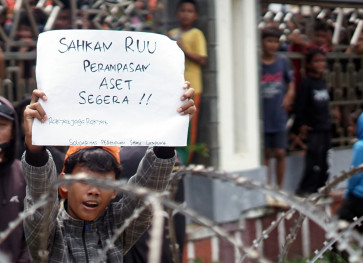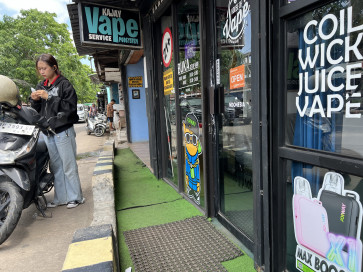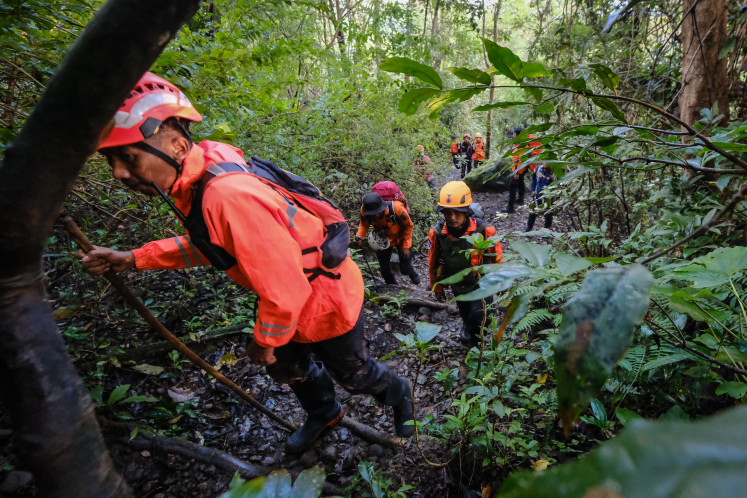Popular Reads
Top Results
Can't find what you're looking for?
View all search resultsPopular Reads
Top Results
Can't find what you're looking for?
View all search resultsRelics from World War II recovered from Bengawan Solo River
Bridging the past: Workers load part of a World War II era pontoon bridge onto a truck on Nov
Change text size
Gift Premium Articles
to Anyone
B
ridging the past: Workers load part of a World War II era pontoon bridge onto a truck on Nov. 7 after lifting it out of the Bengawan Solo River in Lamongan, East Java. Last week, the Education and Culture Ministry’s Cultural Heritage Preservation and Museum Affairs Directorate arranged for three such sunken pontoon bridge components to be lifted from the river.(JP/Asip Hasani)
The recent discovery of boat-shaped artifacts assumed to be part of a pontoon bridge left by the Dutch East Indies colonial government in the Bengawan Solo River in Lamongan, East Java, are reminders of how Allied forces were initially defeated in the Southeast Asian theater during World War II.
The sunken pontoons had been found by sand miners in Mertani village, Lamongan regency, East Java, in early October after a prolonged dry season led to an unusual drop of water levels in the river.
Archaeologists said the American-British-Dutch-Australian (ABDA) Command, which was attempting to prevent the southward advance of Japanese forces, probably ordered the sinking of the pontoon bridge shortly after the Japanese began their invasion of Java in early 1942.
The three boat-shaped pontoons pulled from the longest river on Java would have served to support the bridge's platform. Made of steel, each pontoon measured 7.6 meters long, 1.55 m wide and 0.77 m tall.
“To cross the Bengawan Solo River, supposedly dozens of these components were needed, but we have only found three units,” said Abi Kusno from the Education and Culture Ministry's Cultural Heritage Preservation and Museum Affairs Directorate, which funded the recovery.
On the hulls of the pontoons were printed "MEB-6".
“Based on our research, MEB is an abbreviation for 'Military Equipment Bridging'. It indicates that the pontoon bridge that was once in this location was made by the United States military, but was used by the Dutch East Indies military,” said Stefanus, a researcher for the Indonesia Maritime Archaeology Society, which was involved in the project.
The excavation team also found several coins in Dutch East Indies currency: a 1 gulden coin made in 1902, a 0.5 gulden coin made in 1909 and a 2.5 gulden coin also made in 1909. Additionally, the team found a bullet that was believed to have been for an assault rifle commonly used by the military.
The recovery of the pontoons and the excavation of the additional artifacts took almost a week, starting on Nov. 1.
The archaeologists involved were particularly interested in several holes discovered in the bottom of each pontoon. These seemingly randomly placed holes, each about 3 centimeters in diameter, were believed to have been made by high-caliber bullets, specifically fired to cause the pontoon bridge to sink.
Stefanus said the sinking of the pontoon bridge, which connected the northern region of Lamongan with Gresik, occurred during battles early in World War II when the ABDA Command was failing to prevent the Japanese military from invading several European colonies in Southeast Asia, including the Dutch East Indies.
Allied forces had suffered a series of defeats, including the Battle of Java Sea on Feb. 27, 1942, and the Battle of Sunda Strait on the following day, which paralyzed almost all ABDA Command naval forces. Most of the US and British forces retreated to Australia as, on Feb. 28, 1942, Japanese troops began landing at a number of points on the north coast of Java. Only the Dutch troops and some remaining members of the ABDA Command, particularly British soldiers, were left to defend against the invaders.
After landing at Rembang regency, Center Java, some Japanese soldiers moved eastward with the aim of capturing Surabaya. Other Japanese troops moved toward the center of Java through Jombang and toward the north through Lamongan. Responding to the situation, on March 2, 1942, the last governor-general of the Dutch East Indies, Tjarda van Starkenborgh, ordered all military forces and civil workers to leave their posts in the area within four days.
“Japanese military records mentioned that several bridges on the Bengawan Solo River were purposely damaged by Dutch forces in order to obstruct the movement of Japanese forces, including the bridges in the Lamongan region,” said Stefanus. “Referring to the orders of Tjarda van Starkenborgh, the withdrawal of the Dutch forces and Dutch East Indies civil officers happened from March 2 to 6 and in a very limited time.”
Based on that context, Stefanus said he was convinced that the remnants of the pontoon bridge recently found in the Bengawan Solo River belonged to the Dutch East Indies forces, which purposely sank them before they left in order to avoid a clash with the Japanese military.
This story about the retreat of the Dutch forces and civil officials retreat was confirmed by accounts passed down from the ancestors of the people of Mertani village.
Mertani village secretary Iwan said that the Dutch colonial authorities had two buildings in the vicinity of the pontoon bridge, namely a military post and a pawnshop. These buildings now serve as the Indonesian Army headquarters for the Karanggeneng district and the Mertani village hall.
“My grandfather said that when the Japanese came, the Dutch military had already left. So the military post and pawnshop were empty and people started to fight over what was left, especially in the pawnshop. He said that a lot of people got money, gold and valuable items from the pawnshop,” said Iwan.
On March 9, 1942, the Dutch and other Allied forces still on Java surrendered to the Japanese.
The Lamongan regency administration has shown enthusiasm for the recovery of the bridge pontoons in its jurisdiction and announced it intends to include them in the collection of a museum that is currently under construction.
“Hopefully these historic items can serve as a reminder for future generations about the events that underlie the sinking of the pontoon bridge in the Bengawan Solo River that crosses Lamongan,” said Alamudin, the head of culture division at the Lamongan Culture and Tourism Agency. (vel/kes)










